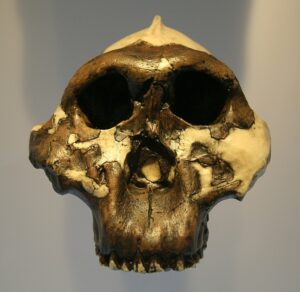The formation of our planet
Our solar system was born around 4.6 billion years ago (later abbreviated to Ga). It was formed within a large cloud of gas and dust. Under the effect of gravitation, the matter in this primitive cloud moved closer together, forming a ball of gas at its center. The temperature rose and a star, the Sun, began to shine. The rest of the primitive cloud remained orbitng the Sun. Bodies of matter gradually coalesced, giving rise to the planets a few million years later. The Earth was formed around 4.56 Ga ago.
How does life appear?
Nevertheless, the conditions necessary for the appearance of life on Earth were far from being met. Temperatures exceeded 100°C and our planet is covered by an ocean of magma. It took several million years before the temperature dropped and oceans and continents formed (between 4.5 and 4.4 Ga). The first life forms began to appear between 4 and 3.8 Ga. Around 4 Ga, organic matter formed from gases such as nitrogen, methane and carbon dioxide. This gives rise to proteins and nucleic acids, which are essential constituents of living organisms.
The first living organisms.
The oldest fossil traces of living organisms date back to 3.8 Ga with the stromatolites. These are sedimentary constructions resulting from the biological activity of very ancient bacteria. These bacteria photosynthesize by capturing carbon dioxide from the atmosphere and releasing oxygen. This type of bacteria still exists today. These are the cyanobacteria. The oldest traces of stromatolites have been found in Australia and Argentina. The emergence of life as we know it today is intimately linked to oxygen, a gas that is indispensable to many of today’s living organisms. Although it began to be released around 3.8 Ga, it wasn’t until around 2.6 Ga that the concentration of oxygen in the atmosphere became significant.
Conditions for the emergence of life
Three main conditions are necessary for the emergence of life as we know it: a continental crust, an oxic atmosphere and the presence of water in liquid form. Let’s not forget that one of our planet’s main characteristics is the abundant presence of liquid water. Indeed, for a long time to come, life continued to be confined to the aquatic realm. It was not until 400 million years ago (later abbreviated to Ma) that the first land animals emerged!
The mechanisms behind the appearance of the first organisms are unknown. Nevertheless, we do know that all living things today have a common origin, given that all living beings possess the molecules we mentioned earlier (proteins and nucleic acids, and also RNA and DNA). Scientists are obviously looking for the last common ancestor of all living things. This hypothetical ancestor is nicknamed LUCA, an acronym for Last Universal Common Ancestor. But be careful! LUCA is only the ancestor of today’s organisms. Other forms of life may have existed, but they simply didn’t leave any descendants.
Milestones in the history of life
Here are a few milestones in the history of life.

And what about human beings?
Human history began between 8 and 5 Ma, well after the appearance of our planet and the emergence of life on Earth! The time scale is dizzying, and this allows us to emphasize an important point: the notion of long and short time periods. 8 Ma may seem like a long time to us, but on the scale of our planet, it’s nothing at all! And it’s even shorter when we consider the emergence of the Homo genus 2.8 Ma ago or Homo sapiens around 300,000 years ago! Time is relative!
Don’t hesitate to ask us questions and give us your feedback on the blog. You can also contact us by e-mail. You can also follow us on Instagram, Facebook, Twitter, TikTok, Linkedin and YouTube!
See you soon,
The Prehistory Travel team.
Bibliography:
- [1] Forterre P, Gribaldo S., “The origin of modern terrestrial life”, HFSP J., 2007, 1(3):156-68. doi: 10.2976/1.2759103.
- [2] Forterre P., Gribaldo S., Brochier C. (2005) – ” Luca : à la recherche du plus proche ancêtre commun universel “, Med Sci (Paris), vol. 21, n°10, 2005.
- [3] Grimaud-Hervé D., et al, History of ancestors. The great adventure of prehistoryEditions Errance, 2015
- [4] https://lejournal.cnrs.fr/billets/luca-une-cellule-un-monde-et-nous
- [5] https://www.radiofrance.fr/franceinter/podcasts/la-terre-au-carre/les-origines-du-vivant-9687441



